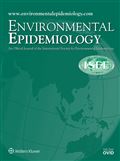Environmental EpidemiologySCIE
国际简称:ENVIRON EPIDEMIOL 参考译名:环境流行病学
-
CiteScore分区
Q1
- JCR分区
- 基本信息:
- ISSN:2474-7882
- 是否OA:开放
- 是否预警:否
- 出版信息:
- 出版地区:United States
- 出版商:Wolters Kluwer
- 出版语言:English
- 研究方向:Medicine-Public Health, Environmental and Occupational Health
- 评价信息:
- 影响因子:3.3
- CiteScore指数:5.7
- SJR指数:1
- SNIP指数:0.85
- 发文数据:
- Gold OA文章占比:96.53%
- 研究类文章占比:100.00%
- 年发文量:43
英文简介Environmental Epidemiology期刊介绍
Environmental Epidemiology is an academic journal dedicated to the study of environmental epidemiology, exploring the relationship between human health risks and environmental hazards. The research content of this journal is mainly based on public health monitoring, relying on the analysis of data from small and sparse population groups, with a focus on identifying very subtle human health impacts or early evidence. Environmental epidemiology plays an important role in public education and risk communication, especially with the development of effective biomarkers for monitoring exposure and precursor health effects, which will greatly advance the discipline.
The research method of the journal has established a statistical monitoring mechanism to monitor the population level disease rate of high-risk populations for early risk identification and sentinel event identification. The advancement of geographic methods, especially the advantages of spatial research, has brought new opportunities for environmental epidemiology. Although these advances still need further refinement and experimentation within the discipline, they are crucial for understanding environmental epidemiological considerations such as industrial expansion, hazardous waste management, and pollution remediation. The goal of the journal is to provide a platform for researchers to share their research on how environmental factors affect human health and well-being. This journal is suitable as a textbook for introductory courses in environmental epidemiology, suitable for undergraduate and graduate students in public health, as well as on-site public health workers. The characteristics of a journal include chapter topics covering the basic concepts, research methods, and application areas of environmental epidemiology, clear presentation of learning objectives, and summarization and clarification of important concepts and information through tables and graphics.
期刊简介Environmental Epidemiology期刊介绍
《Environmental Epidemiology》该刊近一年未被列入预警期刊名单,目前已被权威数据库SCIE收录,得到了广泛的认可。
该期刊投稿重要关注点:
- 预计审稿时间: 25 Weeks
- SCIE
- 非预警
Cite Score数据(2024年最新版)Environmental Epidemiology Cite Score数据
- CiteScore:5.7
- SJR:0.998
- SNIP:0.854
| 学科类别 | 分区 | 排名 | 百分位 |
| 大类:Medicine 小类:Public Health, Environmental and Occupational Health | Q1 | 152 / 665 |
77% |
| 大类:Medicine 小类:Epidemiology | Q2 | 49 / 148 |
67% |
| 大类:Medicine 小类:Pollution | Q2 | 58 / 167 |
65% |
| 大类:Medicine 小类:Global and Planetary Change | Q2 | 44 / 120 |
63% |
| 大类:Medicine 小类:Health, Toxicology and Mutagenesis | Q2 | 56 / 148 |
62% |
CiteScore 是由Elsevier(爱思唯尔)推出的另一种评价期刊影响力的文献计量指标。反映出一家期刊近期发表论文的年篇均引用次数。CiteScore以Scopus数据库中收集的引文为基础,针对的是前四年发表的论文的引文。CiteScore的意义在于,它可以为学术界提供一种新的、更全面、更客观地评价期刊影响力的方法,而不仅仅是通过影响因子(IF)这一单一指标来评价。
JCR分区Environmental Epidemiology JCR分区
| 按JIF指标学科分区 | 收录子集 | 分区 | 排名 | 百分位 |
| 学科:ENVIRONMENTAL SCIENCES | ESCI | Q2 | 159 / 358 |
55.7% |
| 学科:PUBLIC, ENVIRONMENTAL & OCCUPATIONAL HEALTH | ESCI | Q1 | 96 / 403 |
76.3% |
| 按JCI指标学科分区 | 收录子集 | 分区 | 排名 | 百分位 |
| 学科:ENVIRONMENTAL SCIENCES | ESCI | Q2 | 131 / 359 |
63.65% |
| 学科:PUBLIC, ENVIRONMENTAL & OCCUPATIONAL HEALTH | ESCI | Q2 | 153 / 403 |
62.16% |
JCR分区的优势在于它可以帮助读者对学术文献质量进行评估。不同学科的文章引用量可能存在较大的差异,此时单独依靠影响因子(IF)评价期刊的质量可能是存在一定问题的。因此,JCR将期刊按照学科门类和影响因子分为不同的分区,这样读者可以根据自己的研究领域和需求选择合适的期刊。
投稿常见问题
-
请问这本期刊属于什么级别呢?可用于职称评定吗?
一般刊物只分省级、国家级、核心,期刊本身是没有几类划分的,具体是几类或者几级,您可以对照单位的分类文件确认一下。Environmental Epidemiology杂志是由Wolters Kluwer出版的一本SCIE,可用于职称评定。
-
你们能够提供哪些核心期刊的咨询服务?
大多数核心期刊我们都是可以提供咨询服务的。目前核心期刊主要分为以下几类:1.国内核心:按照权威度排序,社科类:南大核心>南大扩展>北大核心>科技核心 按照权威度排序。工科类:CSCD C库>CSCD E库(相当于CSCD扩展)>北大核心>科技核心。2.国外核心(全英文):按照权威度排序为:SSCI=SCI>EI>ISTP=CPCI。
-
想快速发表,可以加急吗?
为了确保您的职称评定顺利进行,我们建议提前半年到一年开始准备,这样能够保证有充足的时间来处理所有相关事宜。如果客户需要加急服务,我们会与杂志社进行沟通,以确定是否可以提供加急服务。请注意,如果确认可以加急,可能会收取一定的加急费用。
-
你们提供的服务可以确保稿件被发表吗?
期刊编辑会综合考虑多个因素,如发表范围、学术价值和原创性等,对稿件进行综合评估。尽管任何机构均无法保证每篇稿件都会被发表,但我们可以用专业知识和丰富经验,协助您理解并遵循期刊的发表要求,从而提高您的稿件被发表的机率。
-
请问期刊发表的费用如何?
期刊发表的费用因期刊不同而异。根据您的需求,我们会为您推荐性价比最高的期刊,并提供专业的期刊供您选择。一般来说,只要符合职称要求,大多数作者都会选择性价比最高的期刊作为意向期刊进行重点咨询。我们会为您提供详细的期刊信息和费用说明,以确保您能够做出明智的选择。
-
如果稿件被拒,未能成功发表,费用是否可以退还?
一般来说,我们推荐的期刊和您的专业方向、文章情况都是匹配的,极少出现稿件被拒的情况。如果稿件被拒,期刊编辑会提供详细的拒稿信和建议,以帮助您了解拒稿原因并改进您的稿件。关于退款政策,具体情况可能因期刊不同而异,请您咨询我们的工作人员以获取详细信息。
